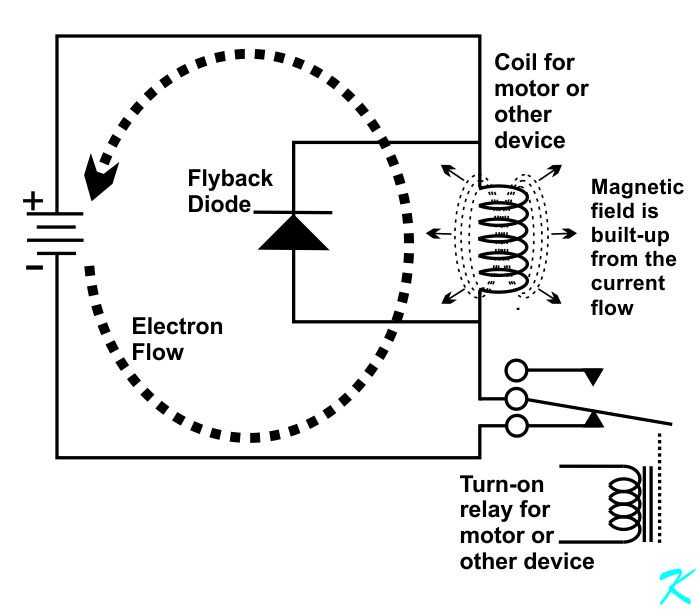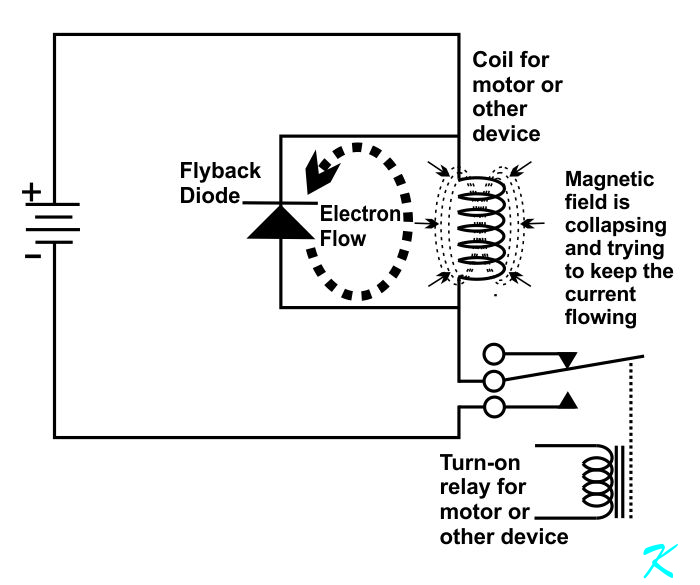Flyback Diode
A motor coil, relay coil, fire alarm door holder, etc. operates by magnetism. Moving electrons in a wire creates magnetism.
There is a direct relationship between electrons moving in a wire or a coil and the magnetic field around the wire. If the electrons are moving, there has to be a magnetic field created by the electrons; if the electrons are not moving, there cannot be a magnetic field, at least one that's created by the electrons in the wire.
Wires in a circuit are usually kind of straight. The magnetic fields (inductance) around the straight wires is very weak and usually can be ignored. However, when the wire is coiled together, the magnetic field strength is multiplied (more inductance). Including a magnetism-conductor, like an iron core, increases the strength of the magnetic field even more.

When the motor current is turned on by the relay, the current flow isn't instant, the current flow is slowed down (impeded) as the electrons in the motor builds up a magnetic field. That isn't the problem with the relay contacts; a slow building up of current (in the microsecond to millisecond range) doesn't damage the contacts.
The constant flow of electrical current isn't the problem either.

It's the sudden relaxing and opening up of the contacts of the relay that's the problem. The collapsing magnetic field pushes on the electrons in the wire. The extra push is a voltage surge, produced by the coil, keeping the electrons moving in the same direction through the coil.
The collapsing magnetic field doesn't increase the number of electrons that are moving; the collapsing magnetic field only pushes the same number of electrons. In other words, the collapsing magnetic field doesn't increase current, it just keeps the current going.
If there's no safety valve (flyback diode) to shunt this current back into the coil, the collapsing magnetic field increases the voltage of the coil to whatever is needed to push the electrons that were originally moving through the coil.
I've seen this voltage surging up to several hundreds of volts. The duration of the voltage is extremely short, microseconds to milliseconds, but the voltage will push the electrons across whatever turned off the current. In this case, the electrons are pushed across the opened-up relay contacts, burning and pitting the contacts.
Minimum Diode Ratings
The diode is a regular diode, rated in forward current capability and reverse voltage capability.
Keep in mind that in electronics and electricity, there is no such thing as absolutes. It better to leave a little headroom on the side of safety than to calculate to the fourth digit.
Because the collapsing magnetic field doesn't increase current, the minimum forward current capability of the diode is the normal current rating of the motor. According to the data, 1000 watts, at 60 volts gives slightly less than 17 amps.
The motor uses 60 volts, so the power supply is providing 60 volts. The diode cannot conduct electricity when the power supply is providing current to the motor. That means that the diode's reverse voltage rating has to be at least 60 volts.
Real Diode Ratings
Although they don't say it this way, manufacturers tend to provide their ratings as "Under the Best Possible Conditions, with Immaculate Heat Protection in the Installation, these Ratings should NEVER be Exceeded, even for Short Durations".
OK, any calculation that's come up with should be doubled, just for component safety.
For the forward current capability of the diode, it should be twice the 20 amps, or actually 40 amps. Higher forward current isn't a problem, it just means that the diode is bigger and more rugged.
For the reverse voltage rating, the diode should be twice the 60 volts, or actually 120 volts. Higher reverse voltage isn't a problem, it just means that a greater voltage is needed to burn out the diode.
If the exact ratings aren't available, go to the next higher rated diode.
Close to the Source of the Voltage Surge
The flyback diode should be installed as close to the motor as possible. The motor is the source of the voltage surge, so the diode should be mounted on or next to the motor.
Keep in mind, the wires in the circuit have a little resistance, and the wires have a little inductance. Use that resistance and inductance to your advantage and keep the circuit wiring between the power supply and the relay on the one hand, and the motor and flyback diode on the other hand.
Mechanical Relay
Mechanical relays aren't affected very much when their ratings are exceeded by a little, at least compared to the solid-state relays. Mechanical relays have copper wire windings, and copper or silver contacts. Little sparks don't affect mechanical relays.
Solid state relays usually have extra protective circuitry in them, but exceeding the manufacturer's ratings, even a little bit and for short durations, can damage or destroy solid-state relays. In other words, little sparks can easily destroy solid state relays.
Also, even though the ratings of solid-state relays imply total isolation between the control voltage and the "contacts", there are limits to how isolated they really are. If there is a serious need for isolation between the relay's control voltage and the motor, it is far better to use a mechanical relay.
As an example, life safety fire alarm systems never use solid-state relays anywhere in their system. They require total isolation.
DC Only
A diode used as a flyback diode is a snubber. Snubbers are used with AC motors and magnets, and with DC motors and magnets. Diodes, though, can only be used with DC motors or magnets.
Douglas Krantz



